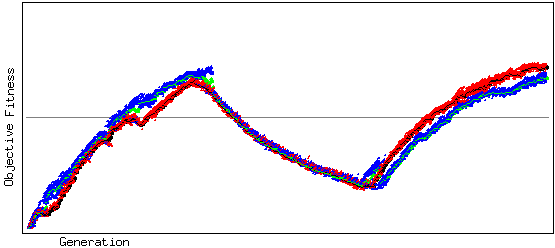
| Relativism / Intransitivity. Comparing members
of one population against members of another population, and vice versa,
can be difficult in games which have 'circular superiority' or intrasitivity.
If the fact that A beats B, and B beats C, does not necessarily mean that
A beats C, then the game is not transitive and this can cause evolutionary
difficulties. For example, sometimes a skill doesn't have an objective
direction for improvement, hence depending on the opponent the player might
develop the skill in different directions. Lets say one skill is playing
aggressively/defensively in chess. Increasing aggressiveness might increase
performance against some opponents, while increasing defensiveness might
be required to increase fitness against other opponents.
For each game between 'a' and an opponent, determine D, the dimension/skill in which they are least different. The winner is the player that is greater in dimension D. i.e. fitness of a is 1 if a[D] > Opponent[D], 0 otherwise. In this game only one skill is relevant when playing against a particular player and which skill matters depends on who you play. However, in this game, a change that increases your score against one player can decrease your score against another player - this makes the game intransitive. Look for dynamics that are radically different in this intrasitive game. The two populations race in different directions, not always upwards. This is beacuse in this intrasitive game it is not clear from playing a sample of opponents 'which way is up', so subjective improvement does not necessarily correspond at all with objective improvement. Note that the downward trends in objective fitness are not accompanied by polarisation of the subjective fitnesses as they were in experiment 1b - in this expeiment the downward trends are not caused by disengaement and drift, the populations are actively racing each other in the wrong direction! Now, go see these experiments live in the simulation. |
| Go see dynamic simulation. |